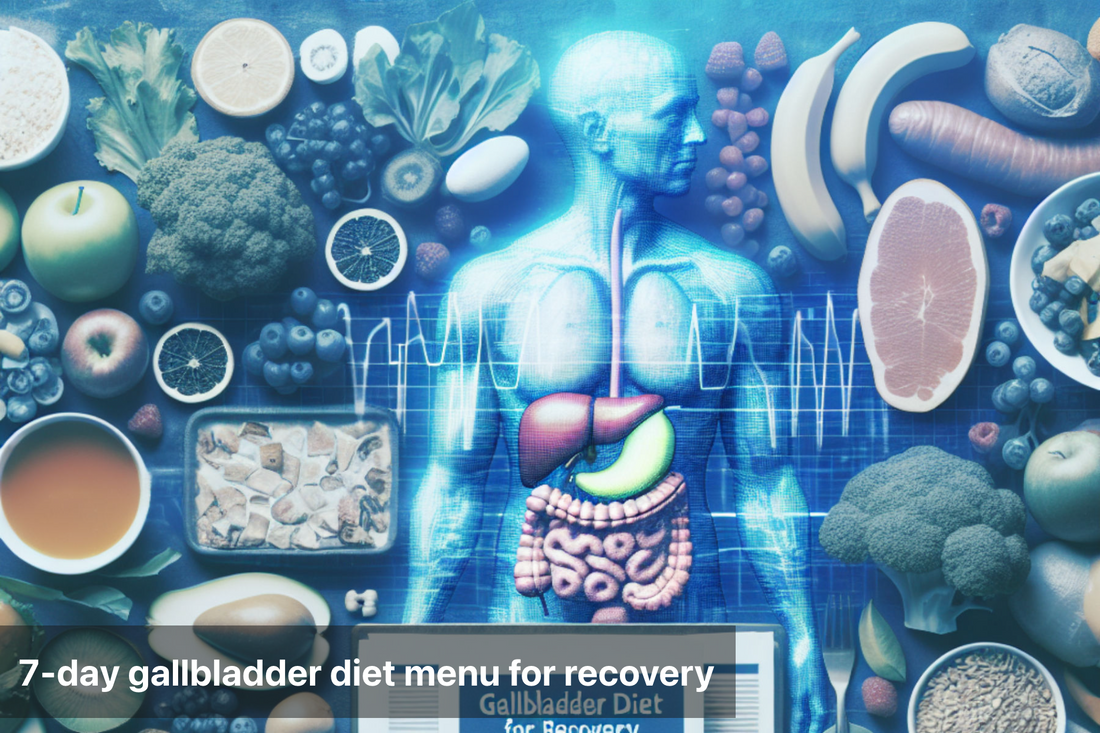
7-day gallbladder diet menu for recovery
Share
Recovering from gallbladder issues—whether after a gallbladder removal (cholecystectomy), gallstones, or inflammation—requires dietary adjustments that support digestion and reduce strain on the digestive system. A gallbladder-friendly diet focuses on low-fat, high-fiber, and nutrient-rich foods that prevent bile overload and promote smoother digestion during the healing process.
Here’s a complete 7-day sample menu to help you recover effectively, minimize symptoms like bloating or indigestion, and gradually reintroduce balanced nutrition.
Goals of a Gallbladder Recovery Diet
Limit fat intake, especially saturated and trans fats
Prevent indigestion and bile-related discomfort
Support liver function, which takes over bile regulation
Promote bowel regularity with fiber-rich but gentle foods
Avoid triggering symptoms like nausea, diarrhea, or gas
Foods to Focus On During Recovery
Lean proteins: Boiled eggs, skinless chicken, lentils, tofu
Low-fat dairy: Skim milk, low-fat curd, unsweetened yogurt
Easily digestible carbs: Oats, rice, quinoa, boiled potatoes
Cooked vegetables: Carrots, beans, zucchini, spinach, lauki
Fruits (non-acidic): Bananas, apples (peeled), papaya, melons
Healthy fats (in small amounts): Olive oil, flaxseed oil, avocado (only after symptoms subside)
Foods to Strictly Avoid
Fried foods, red meat, high-fat dairy, butter, ghee
Spicy gravies, heavy curries, pickles, and chutneys with oil
Creamy desserts, cheese, mayonnaise
Carbonated beverages, packaged juices, and coffee (if acidic)
Cruciferous raw vegetables (like cabbage, broccoli in early days)
Processed snacks, bakery goods, and sugar-heavy foods
7-Day Gallbladder Recovery Meal Plan (Sample Menu)
Day |
Breakfast |
Lunch |
Snack |
Dinner |
|---|---|---|---|---|
1 |
Steamed oats + banana |
Moong dal + soft rice + boiled carrots |
Papaya cubes |
Lauki soup + toast (no butter) |
2 |
Poha with peas (low oil) |
Masoor dal + quinoa + sautéed spinach |
Coconut water + khakra |
Vegetable khichdi + curd |
3 |
Ragi porridge with dates |
Tofu stir-fry + rice + pumpkin sabzi |
Steamed apple + cinnamon |
Moong dal soup + suji upma |
4 |
Dalia with cardamom |
Bottle gourd curry + millet roti |
Buttermilk + murmura |
Carrot-beet soup + rice flakes (chivda) |
5 |
Idli + mint chutney (no oil) |
Arhar dal + jeera rice + beans poriyal |
Herbal tea + roasted makhana |
Quinoa pulao + cucumber raita |
6 |
Smoothie (banana + oats) |
Chana dal + boiled potato sabzi |
Dates + roasted chana |
Suji khichdi + curd |
7 |
Besan chilla + coriander dip |
Lauki curry + brown rice + spinach |
Chamomile tea + fruit salad |
Roti + dal + sautéed ridge gourd |
Note: All meals are cooked using minimal oil and no heavy masalas. Adjust spices and consistency according to tolerance.
Essential Cooking Tips for Gallbladder Recovery
Steam, boil, or sauté—avoid deep-frying or pressure-cooking with too much oil
Use minimal oil: 1–2 tsp/day of olive oil or flaxseed oil is enough
Peel fruits and vegetables if fiber feels too heavy in early recovery
Eat smaller, frequent meals to avoid overwhelming your digestive system
Avoid mixing fat and fiber heavily in one meal during the first week
Nutritional Focus During Recovery
Nutrient |
Why It Matters |
Best Sources |
|---|---|---|
Protein |
Tissue repair, energy |
Lentils, tofu, low-fat yogurt, dal |
Fiber |
Prevent constipation |
Oats, cooked veggies, fruits |
Potassium |
Electrolyte balance |
Bananas, coconut water, potatoes |
Vitamin C |
Immunity, healing |
Papaya, amla, guava (when tolerated) |
Probiotics |
Gut health post-antibiotics |
Plain curd, buttermilk |
Signs Your Diet Is Working
Reduced bloating and acid reflux
Regular and easy bowel movements
No greasy stools or abdominal cramps
Steady energy levels without heaviness
Tolerance for gradually reintroduced foods
Precautions and Red Flags
Avoid excess fiber or raw veggies too soon—they can irritate the gut
Skip caffeine, spicy foods, or alcohol for at least 2–3 weeks
Don’t fast or overeat—both stress bile regulation
Watch for symptoms like yellow stools, sharp pain, or vomiting—consult a doctor if persistent
Reintroduce fats gradually—wait 1–2 weeks before adding nuts, avocado, or ghee
Frequently Asked Questions
Q. Can I eat fruit during gallbladder recovery?
Yes, but stick to low-acid and soft fruits like banana, apple (peeled), papaya, and musk melon.
Q. How soon can I eat normally after gallbladder surgery?
Light, low-fat meals can be started within a day or two. Normal diet is usually resumed after 3–4 weeks depending on symptoms.
Q. Is curd safe after gallbladder issues?
Yes, low-fat plain curd and buttermilk aid digestion and gut recovery.
Summary
A 7-day gallbladder-friendly diet emphasizes soft, low-fat, high-fiber meals to support digestion and recovery. With gentle cooking methods, small frequent portions, and careful food choices, you can reduce symptoms and gradually return to a balanced diet. Listening to your body and staying consistent with simple, nourishing meals is key to healing smoothly.






